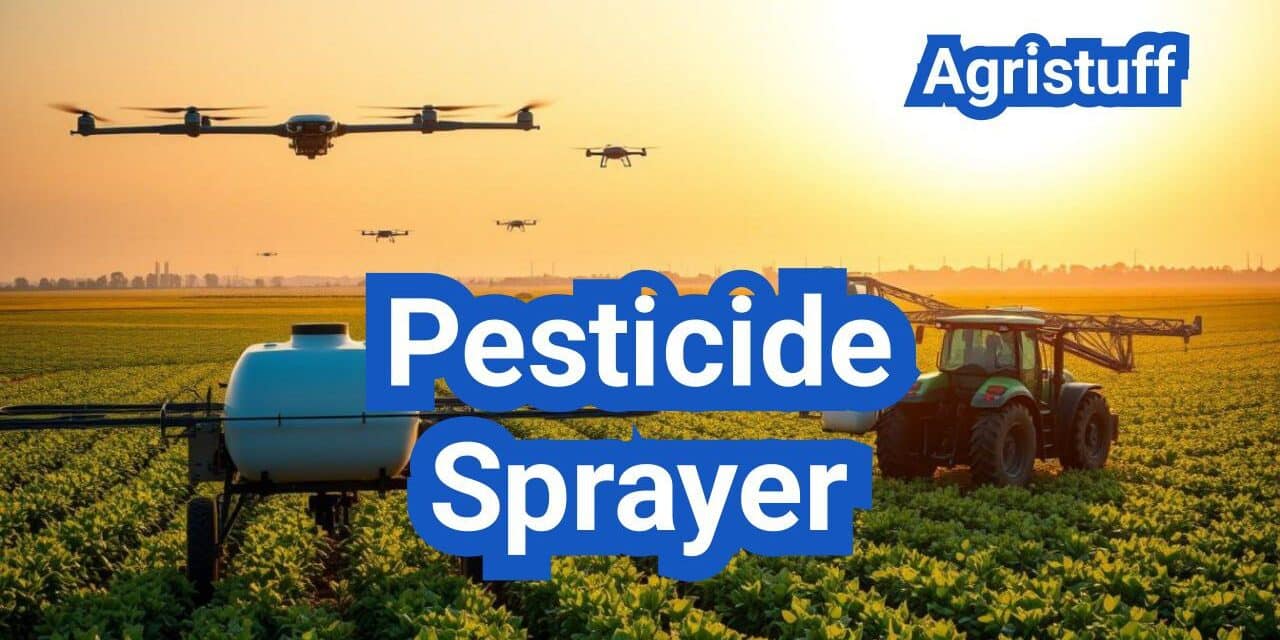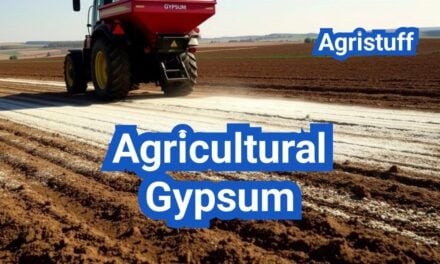Modern agriculture relies heavily on advanced equipment to manage crop health and growth. One crucial piece of machinery is the agricultural spraying equipment, which has revolutionized the way farmers protect their crops.
The self-propelled sprayer is a prime example of this technology, offering a range of benefits including increased efficiency and reduced labor costs. Various types of sprayers are available, including pump, drone, machine, electric, nozzle, and tractor-mounted models.
These sprayer systems enable farmers to apply pesticides and fertilizers more effectively, resulting in healthier crops and higher yields.
Key Takeaways
- Efficient crop management is crucial for modern farming.
- Advanced agricultural spraying equipment improves crop yields.
- Various types of sprayers cater to different farming needs.
- Self-propelled sprayers offer increased efficiency and reduced labor costs.
- Effective pesticide application results in healthier crops.
The Essential Role of Pesticide Sprayers in Modern Agriculture
In modern agriculture, pesticide sprayers are vital tools for farmers to protect their crops and enhance productivity. These devices are designed to apply pesticides efficiently and effectively, ensuring that crops receive the necessary protection against pests and diseases.
What Defines an Effective Pesticide Sprayer
An effective pesticide sprayer is characterized by its ability to deliver the correct amount of pesticide to the target area. This involves a combination of proper nozzle selection, adequate pressure, and appropriate sprayer calibration.
The dynamic system of modern pesticide sprayers predominantly employs robust diesel engines or high-performance electric motors. These power sources enable the sprayer to maintain consistent pressure and flow rates, crucial for effective spraying.
| Feature | Description | Benefit |
|---|---|---|
| Robust Construction | Built with durable materials | Longer lifespan and reduced maintenance |
| Adjustable Nozzles | Allows for different spray patterns | Versatility for various crop types |
| Precise Calibration | Ensures accurate pesticide application | Reduced waste and environmental impact |
Impact of Proper Application on Crop Yield and Environment
Proper application of pesticides through effective sprayers significantly impacts both crop yield and environmental sustainability. By ensuring that the correct amount of pesticide is applied to the target area, farmers can maximize crop yields while minimizing environmental impact.
Effective spraying techniques help reduce the risk of pesticide drift and runoff, protecting surrounding ecosystems and water sources. This not only contributes to environmental sustainability but also helps in maintaining a healthy crop yield.
Types of Pesticide Sprayers for Different Applications

Different types of pesticide sprayers are available for various applications in agriculture. The choice of sprayer depends on factors such as farm size, crop type, and the level of precision required.
Manual vs. Powered Sprayers
Manual sprayers are suitable for small farms or gardens and are often more affordable. However, they can be labor-intensive and may not provide uniform coverage. Powered sprayers, on the other hand, offer greater efficiency and consistency, making them ideal for larger operations.
Stationary vs. Mobile Systems
Stationary systems are typically used for specific tasks or in areas where mobility is not necessary. Mobile systems, including backpack sprayers and tractor-mounted sprayers, provide flexibility and are suitable for a wide range of applications.
Choosing Based on Farm Size and Crop Type
When selecting a pesticide sprayer, it’s essential to consider the size of the farm and the type of crops being grown. For example, large farms with dense crops may benefit from tractor-mounted sprayers equipped with advanced technology, such as GPS guidance. In contrast, smaller farms or those with varied crop types might prefer more versatile options like backpack sprayers.
The innovative walking system features both wheeled and tracked options to navigate diverse terrains with ease, making it an excellent choice for farms with challenging landscapes.
By understanding the different types of pesticide sprayers available, farmers can make informed decisions to optimize their pest management strategies and improve crop yields.
Pump Sprayers: How to Select and Operate Effectively
Pump sprayers are a vital tool in agriculture, requiring careful selection and operation. The right pump sprayer can significantly enhance the efficiency of pesticide application, impacting both crop yield and environmental sustainability.
Diaphragm vs. Piston Pump Mechanisms
When selecting a pump sprayer, understanding the differences between diaphragm and piston pump mechanisms is crucial. Diaphragm pumps, known for their durability and resistance to corrosion, are ideal for applications involving abrasive chemicals. On the other hand, piston pumps offer high pressure and are suitable for larger-scale operations. Brands like SHURflo and Hypro offer a range of sprayer pumps with different specifications and features, catering to various agricultural needs.
Step-by-Step Guide to Operating a Pump Sprayer
Operating a pump sprayer effectively involves several key steps.
Priming the Pump
First, priming the pump is essential to ensure that it operates smoothly. This involves removing any air from the system to facilitate the flow of pesticide.
Maintaining Consistent Pressure
Next, maintaining consistent pressure is vital for uniform application. Regular checks on the pump’s pressure gauge can help in achieving this consistency, ensuring that the pesticide is applied effectively across the target area.
By understanding the type of pump mechanism and following the operational guidelines, farmers can optimize their pesticide application, enhancing both efficiency and effectiveness.
Backpack Pesticide Sprayers: Maximizing Efficiency and Comfort

Maximizing efficiency and comfort, backpack pesticide sprayers are designed to meet the diverse needs of modern farming practices. These sprayers offer a versatile solution for pesticide application, suitable for various crop types and farm sizes.
Manual vs. Battery-Powered Models
Backpack sprayers come in two primary types: manual and battery-powered. Manual sprayers are cost-effective and simple to maintain, making them ideal for small-scale operations or areas with limited power supply. On the other hand, battery-powered sprayers offer greater convenience and reduced user fatigue, especially for larger areas or more frequent applications.
- Manual sprayers are suitable for small farms or gardens.
- Battery-powered sprayers are ideal for larger operations.
Proper Fitting and Weight Distribution
Proper fitting and weight distribution are crucial for the effective use of backpack sprayers. Ensuring the sprayer is correctly adjusted to the user’s body reduces strain and enhances mobility. Weight distribution should be evenly balanced to prevent tilting or leaning, which can lead to uneven spraying.
Application Techniques for Precise Coverage
Achieving precise coverage is vital for effective pesticide application. Techniques include maintaining a consistent spraying height and distance, and using the appropriate nozzle type for the target pest and crop. Application techniques vary depending on the crop density and growth stage.
- Adjust the nozzle according to the crop type.
- Maintain a steady pace to ensure uniform coverage.
By understanding the different types of backpack sprayers and employing proper application techniques, farmers can maximize efficiency and comfort while minimizing environmental impact.
Electric Pesticide Sprayers: Setup and Operation Guide
Electric pesticide sprayers have revolutionized the way farmers apply pesticides, offering a quieter and more environmentally friendly alternative. These sprayers are particularly beneficial for use in sensitive areas due to their zero-emission profile and whisper-quiet operation.
Corded vs. Cordless Options
When selecting an electric pesticide sprayer, one of the primary considerations is whether to choose a corded or cordless model. Corded sprayers provide consistent power but are limited by the length of their cord, while cordless sprayers offer greater mobility but require careful battery management.
- Corded sprayers are ideal for fixed locations or areas with easy access to power.
- Cordless sprayers provide greater flexibility and are suitable for larger areas or where power sources are limited.
Battery Management for All-Day Operation
For cordless electric sprayers, effective battery management is crucial to ensure all-day operation. This includes:
- Choosing a battery with sufficient capacity for your needs.
- Implementing a charging schedule to minimize downtime.
- Monitoring battery health to prevent unexpected failures.
Adjusting Output Settings for Different Applications
Electric pesticide sprayers often come with adjustable output settings, allowing users to tailor the application to specific needs.
Fine Mist vs. Jet Stream Settings
The choice between fine mist and jet stream settings depends on the type of pesticide being used and the target area. A fine mist is ideal for broad coverage, while a jet stream is better suited for targeting specific areas or pests.
Coverage Pattern Adjustments
Adjusting the coverage pattern is essential for ensuring that the pesticide is applied evenly and effectively. This may involve changing nozzle settings or adjusting the sprayer’s boom configuration.
Tractor-Mounted Sprayers: Installation and Calibration

The installation and calibration of tractor-mounted sprayers are critical steps in ensuring effective pesticide application. These sprayers are a vital component of modern farming, offering a powerful and efficient means of crop protection.
Three-Point Hitch vs. Pull-Behind Systems
Tractor-mounted sprayers can be categorized into two main types based on their attachment method: three-point hitch and pull-behind systems. Three-point hitch systems are directly attached to the tractor’s hitch, providing stability and maneuverability. In contrast, pull-behind systems are towed behind the tractor, often accommodating larger capacities.
Boom Sprayer Setup and Adjustment
The boom sprayer is a crucial component of the tractor-mounted sprayer, responsible for distributing the pesticide. Proper setup involves adjusting the boom height to ensure uniform coverage and minimize drift. The boom should be level and stable during operation.
PTO Connection and Power Management
The Power Take-Off (PTO) connection is essential for powering the sprayer’s pump. PTO connection requires careful alignment and secure attachment to the tractor’s PTO shaft. Proper power management involves setting the correct PTO RPM to achieve the desired sprayer performance.
Proper PTO RPM Settings
Setting the correct PTO RPM is vital for achieving the optimal flow rate and pressure. The manufacturer’s guidelines should be consulted to determine the recommended RPM for the specific sprayer model.
Hydraulic System Maintenance
Regular maintenance of the hydraulic system is necessary to ensure reliable operation. This includes checking for leaks, inspecting hoses, and replacing worn components as needed.
By following these guidelines for installation, calibration, and maintenance, farmers can optimize the performance of their tractor-mounted sprayers, enhancing crop protection and reducing operational costs.
Agricultural Drone Sprayers: Setup and Flight Planning

Modern farming has seen a shift towards technology-driven solutions, with agricultural drones leading the way in efficient pesticide application. Agricultural drone sprayers are equipped with advanced technology that allows for precise application of pesticides, reducing waste and environmental impact.
Programming Spray Patterns and Coverage
One of the key features of agricultural drone sprayers is their ability to be programmed for specific spray patterns and coverage areas. This is achieved through sophisticated software that allows farmers to input details about their fields and the desired application rates.
Battery Management for Maximum Flight Time
Battery management is crucial for maximizing the flight time of agricultural drones. Most modern drones come with advanced battery management systems that monitor battery health and optimize power consumption.
Compliance with FAA Regulations
Operating an agricultural drone sprayer in the United States requires compliance with Federal Aviation Administration (FAA) regulations. Understanding these regulations is essential for safe and legal operation.
Licensing Requirements
To operate a drone for commercial purposes, including agricultural spraying, the operator must obtain a Part 107 certification from the FAA. This involves passing a knowledge test that covers topics such as airspace regulations and safety procedures.
Airspace Restrictions
Agricultural drone operators must be aware of airspace restrictions, including no-fly zones near airports, national parks, and other sensitive areas. Utilizing FAA-approved drone navigation systems can help in complying with these restrictions.
| Regulation | Description |
|---|---|
| Part 107 Certification | Required for commercial drone operation, including agricultural spraying. |
| Airspace Restrictions | No-fly zones near airports, national parks, and other sensitive areas. |
Understanding and Selecting the Right Sprayer Nozzles

The right sprayer nozzle can significantly impact the efficacy of pesticide application and crop yield. With various types available, selecting the appropriate nozzle is crucial for effective pest control and crop management.
Flat Fan vs. Cone vs. Air Induction Nozzles
Sprayer nozzles come in different configurations, including flat fan, cone, and air induction nozzles. Flat fan nozzles are ideal for broad coverage and are often used for herbicide application. Cone nozzles produce a concentrated spray pattern, making them suitable for insecticide and fungicide applications. Air induction nozzles incorporate air into the spray, reducing drift and improving coverage.
| Nozzle Type | Application | Characteristics |
|---|---|---|
| Flat Fan | Herbicide application | Broad coverage, uniform spray pattern |
| Cone | Insecticide, fungicide | Concentrated spray, effective for dense foliage |
| Air Induction | Various applications | Reduces drift, improves coverage |
Matching Nozzle Type to Target Pest and Crop
Choosing the right nozzle type depends on the target pest, crop, and application method. For instance, when applying herbicides, a flat fan nozzle is often preferred for its broad coverage. In contrast, cone nozzles are better suited for insecticide and fungicide applications where a more concentrated spray is needed.
How to Replace and Maintain Nozzles
Regular maintenance of sprayer nozzles is essential for optimal performance. This includes cleaning and inspecting nozzles regularly.
Cleaning Procedures
To clean nozzles, remove any debris or residue that may affect spray quality. Soak the nozzles in a cleaning solution, then rinse thoroughly.
Wear Indicators
Inspect nozzles regularly for signs of wear, such as increased flow rate or distorted spray pattern. Replace nozzles that show significant wear to maintain application accuracy.
How to Calibrate Any Pesticide Sprayer for Accurate Application

Accurate pesticide application starts with proper sprayer calibration. Calibration ensures that the sprayer applies the correct amount of pesticide or fertilizer, which is crucial for effective crop management and environmental protection.
The Calibration Process Step-by-Step
The calibration process involves several key steps to ensure your sprayer is applying the correct amount of pesticide.
Measuring Output Volume
To begin, measure the output volume of your sprayer. This involves running the sprayer for a set period, then measuring the amount of liquid sprayed. It’s essential to use the same nozzle and pressure settings you plan to use during actual application.
Calculating Application Rate
Next, calculate the application rate based on the sprayer’s output and the area covered. This step is critical to ensure you’re applying the correct amount of pesticide per acre.
| Sprayer Type | Output Volume (gallons/minute) | Application Rate (gallons/acre) |
|---|---|---|
| Boom Sprayer | 2.5 | 15 |
| Backpack Sprayer | 1.2 | 20 |
| Tractor-Mounted Sprayer | 5.0 | 25 |
Adjusting for Different Formulations
Different pesticide formulations may require adjustments to your sprayer’s calibration. Always refer to the product label for specific instructions on application rates and any necessary adjustments.
Verification Techniques
After calibrating your sprayer, it’s crucial to verify that it’s applying the correct amount of pesticide. This can be done by checking the spray pattern, measuring the amount of pesticide used over a known area, or using a flow meter.
By following these steps and verifying your sprayer’s calibration, you can ensure accurate and effective pesticide application, contributing to better crop yields and reduced environmental impact.
Mixing and Loading Pesticides Safely and Accurately

The process of mixing and loading pesticides requires careful attention to detail to ensure safety and efficacy. This step is critical in the pesticide application process, as it directly impacts the effectiveness of the treatment and the safety of the applicator, the environment, and the crop.
Creating a Dedicated Mixing Station
A dedicated mixing station can significantly enhance safety and efficiency. This designated area should be well-ventilated, away from direct sunlight, and equipped with necessary safety features such as spill containment systems and personal protective equipment (PPE).
Key Features of a Dedicated Mixing Station:
- Non-porous surfaces for easy cleaning
- Adequate storage for pesticides and PPE
- Clear labeling and signage
- Emergency response equipment
Calculating Proper Dilution Rates
Accurate dilution is crucial for the effective application of pesticides. The label instructions should always be followed, and calculations should be double-checked to avoid under or over-dosing.
| Pesticide Product | Recommended Dilution Rate | Application Rate |
|---|---|---|
| Product A | 1:100 | 2 quarts/acre |
| Product B | 1:50 | 3 quarts/acre |
Preventing Spills and Contamination
Preventing spills is a critical aspect of safe pesticide handling. This involves using appropriate equipment, following proper procedures, and having emergency response plans in place.
Containment Systems
Effective containment systems are essential for preventing environmental contamination in the event of a spill. These systems should be designed to capture and hold spills, preventing them from spreading.
Emergency Response Procedures
Having a well-planned emergency response procedure is crucial. This should include training for personnel, equipment for containing spills, and procedures for notifying relevant authorities.
Regular drills and training can help ensure that personnel are prepared to respond effectively in case of an emergency.
Application Techniques for Maximum Effectiveness

To achieve optimal results in pesticide application, understanding the right techniques is essential. Effective application techniques not only ensure that crops receive the necessary protection but also help in minimizing environmental impact.
Optimal Spraying Height and Distance
Maintaining the optimal spraying height and distance is critical for ensuring that the pesticide reaches the target area effectively. The recommended height varies depending on the type of crop and the sprayer being used. For instance, a lower spraying height is often used for crops like wheat, while a higher height may be necessary for taller crops like corn.
Weather Considerations and Timing
Weather conditions, such as wind speed and direction, temperature, and humidity, significantly impact the effectiveness of pesticide application. It’s crucial to check the weather forecast before application to avoid conditions that might lead to drift or reduced efficacy.
“The timing of pesticide application is as important as the choice of pesticide itself. Applying at the right time can significantly enhance efficacy and reduce environmental impact.”
Avoiding Drift and Off-Target Movement
Drift and off-target movement can lead to significant losses and environmental contamination. Techniques such as using drift-reducing nozzles and maintaining appropriate spraying speeds can help mitigate these issues.
Wind Speed Guidelines
Wind speed is a critical factor in pesticide application. Wind speeds between 3 and 10 mph are generally considered optimal. Applying pesticides at wind speeds outside this range can lead to drift or inadequate coverage.
Buffer Zone Management
Establishing buffer zones around sensitive areas is a key strategy for preventing off-target movement. The size of the buffer zone depends on the type of pesticide, the application method, and the surrounding environment.
| Application Method | Recommended Buffer Zone |
|---|---|
| Boom Sprayer | 20 feet |
| Aerial Application | 50 feet |
Essential Maintenance for Your Pesticide Sprayer

To ensure your pesticide sprayer operates at peak efficiency, a well-planned maintenance routine is indispensable. Regular maintenance not only prolongs the lifespan of the equipment but also ensures consistent application quality.
Daily Cleaning and Inspection Routines
Daily cleaning is crucial to prevent clogging and corrosion. After each use, flush the sprayer with clean water to remove any residual pesticides. Inspect the nozzles, hoses, and filters for signs of wear or damage.
- Check for leaks in the tank, hoses, and connections.
- Clean nozzles and filters according to the manufacturer’s instructions.
Seasonal Maintenance Schedule
At the end of each spraying season, perform a thorough maintenance check. This includes:
- Draining and cleaning the tank.
- Lubricating moving parts.
- Inspecting and replacing worn-out components.
Winterizing Procedures for Cold Climates
In colder climates, winterizing your pesticide sprayer is vital to prevent damage from freezing temperatures.
Antifreeze Application
Use an appropriate antifreeze in the sprayer system to prevent freezing.
Component Protection
Protect vulnerable components from cold and moisture by storing them in a dry, protected area.
By following these maintenance guidelines, you can ensure your pesticide sprayer remains in good working condition, ready for the next spraying season.
Troubleshooting Common Pesticide Sprayer Issues
Troubleshooting is an essential skill for farmers and agricultural professionals to maintain efficient pesticide application. Pesticide sprayers are complex equipment that can encounter various operational issues, impacting their effectiveness and overall crop yield.
Diagnosing Pressure Problems
Pressure problems in pesticide sprayers can lead to uneven application and reduced efficacy. To diagnose pressure issues, check the pump for any signs of wear or damage. Ensure that all connections are secure and that there are no leaks in the system.
Common causes of pressure problems include:
- Clogged filters or nozzles
- Air leaks in the system
- Incorrect pump operation
Clearing Clogged Lines and Nozzles
Clogged lines and nozzles are common issues that can significantly affect sprayer performance. To clear clogs, start by isolating the affected area. Use a cleaning solution or water to flush out debris.
| Clog Location | Cleaning Method |
|---|---|
| Nozzles | Soak in cleaning solution |
| Lines | Flush with water or cleaning solution |
| Filters | Inspect and clean or replace |
Motor and Pump Repair Basics
Motor and pump malfunctions can be critical issues that require immediate attention. Basic repairs involve checking electrical connections, inspecting for wear, and ensuring proper lubrication.
Seal Replacement
Seal replacement is a common repair task. Identify worn seals, remove them carefully, and replace with new ones, ensuring proper fit and sealing.
Electrical System Checks
For electric or battery-powered sprayers, check the battery condition, inspect wiring for damage, and ensure all connections are secure.
Advanced Pesticide Sprayer Technologies
Advanced pesticide sprayer technologies are revolutionizing farming practices by enhancing precision and efficiency. These technologies are crucial for modern agriculture, enabling farmers to optimize their pesticide application.
GPS-Guided Application Systems
GPS-guided application systems allow for precise pesticide application, reducing overlap and ensuring that crops receive the correct amount of treatment. This technology integrates GPS data to guide the sprayer, improving accuracy and reducing waste.
Variable Rate Technology
Variable Rate Technology (VRT) enables farmers to apply pesticides at varying rates across a field, based on specific conditions such as soil type, crop density, and pest pressure. This targeted approach maximizes efficacy while minimizing environmental impact.
Pulse Width Modulation Systems
Pulse Width Modulation (PWM) systems control the flow rate of pesticides by adjusting the pulse width of the sprayer’s output. This technology ensures consistent application rates, even at varying speeds.
Benefits for Precision Application
The integration of these advanced technologies offers numerous benefits, including improved crop yields, reduced chemical usage, and minimized environmental impact.
Implementation Considerations
When implementing these technologies, farmers should consider factors such as system compatibility, data management, and operator training to ensure successful integration.
| Technology | Benefits | Considerations |
|---|---|---|
| GPS-Guided Application | Improved accuracy, reduced overlap | Initial investment, GPS signal strength |
| Variable Rate Technology | Targeted application, reduced waste | Data management, system complexity |
| Pulse Width Modulation | Consistent application rates | System compatibility, operator training |
Safety Protocols When Using Pesticide Sprayers
Ensuring safety while using pesticide sprayers is crucial for protecting both the applicator and the environment. Pesticide application involves handling potentially hazardous chemicals, making it imperative to follow strict safety guidelines.
Required Personal Protective Equipment
Personal Protective Equipment (PPE) is vital for minimizing exposure to pesticides. This includes gloves, masks, protective eyewear, and coveralls. The type of PPE required may vary depending on the pesticide being used and the spraying method.
| PPE Component | Purpose |
|---|---|
| Gloves | Prevent skin contact with pesticides |
| Masks | Protect against inhalation of pesticide fumes |
| Protective Eyewear | Safeguard eyes from chemical splashes |
Creating Buffer Zones for Sensitive Areas
Buffer zones are critical for preventing pesticide drift into sensitive areas such as water bodies, residential zones, and wildlife habitats. The size of the buffer zone depends on the spraying method, wind conditions, and the type of pesticide used.
Proper Storage of Equipment and Chemicals
Proper storage is essential for maintaining the integrity of pesticides and equipment. This involves storing chemicals in a well-ventilated, secure facility away from living areas.
Secure Storage Facilities
Storage facilities should be designed to prevent unauthorized access and protect against environmental contamination.
Inventory Management Systems
An effective inventory management system helps track pesticide usage and ensures that chemicals are used before they expire.
| Storage Requirement | Description |
|---|---|
| Ventilation | Adequate ventilation to prevent accumulation of fumes |
| Security | Measures to prevent unauthorized access |
| Organization | Systematic storage to facilitate easy retrieval and inventory management |
Sustainable and Effective Pesticide Application
Sustainable and effective pesticide application is crucial for maintaining crop health while minimizing environmental impact. By understanding the various types of pesticide sprayers, their proper operation, and maintenance, farmers and agricultural professionals can significantly enhance their pest management strategies.
Effective pesticide application not only improves crop yields but also reduces the risk of environmental contamination. Technologies such as GPS-guided application systems and variable rate technology are revolutionizing the way pesticides are applied, making the process more precise and efficient.
To achieve sustainable pesticide application, it’s essential to follow best practices, including proper calibration of equipment, safe handling of chemicals, and adherence to safety protocols. By adopting these practices, the agricultural industry can reduce its environmental footprint while maintaining productivity.
As the agricultural sector continues to evolve, embracing innovative technologies and sustainable practices will be key to ensuring a productive and environmentally conscious future.
FAQ
What are the different types of pesticide sprayers available?
Pesticide sprayers come in various types, including pump, drone, machine, electric, nozzle, and tractor-mounted models, each designed for specific applications and farm sizes.
How do I choose the right pesticide sprayer for my farm?
The choice of pesticide sprayer depends on factors such as farm size, crop type, and the level of precision required. Consider manual vs. powered and stationary vs. mobile systems when making your decision.
What is the difference between diaphragm and piston pump mechanisms in pump sprayers?
Diaphragm pumps are known for their durability and resistance to corrosion, while piston pumps offer high pressure and flow rates. The choice between them depends on the specific application and required pressure.
How do I calibrate a pesticide sprayer for accurate application?
Calibrating a pesticide sprayer involves measuring output volume, calculating application rate, and adjusting for different formulations. Verification techniques ensure the sprayer is applying the correct amount.
What are the safety protocols to follow when using pesticide sprayers?
Safety protocols include wearing required personal protective equipment, creating buffer zones for sensitive areas, and proper storage of equipment and chemicals to minimize risks.
How do I maintain my pesticide sprayer?
Regular maintenance includes daily cleaning and inspection routines, seasonal maintenance schedules, and winterizing procedures for cold climates to ensure the sprayer remains in good working condition.
What are the benefits of using advanced pesticide sprayer technologies?
Advanced technologies such as GPS-guided application systems, variable rate technology, and pulse width modulation systems offer improved precision, reduced waste, and increased efficiency in pesticide application.
How do I troubleshoot common issues with my pesticide sprayer?
Troubleshooting involves diagnosing pressure problems, clearing clogged lines and nozzles, and performing basic motor and pump repairs to get the sprayer back in operation.
What are the different types of sprayer nozzles and their applications?
Sprayer nozzles come in various types, including flat fan, cone, and air induction nozzles, each suited for specific pest and crop combinations. Selecting the right nozzle is crucial for effective application.
How do I mix and load pesticides safely and accurately?
Safe mixing and loading involve creating a dedicated mixing station, calculating proper dilution rates, and preventing spills and contamination to minimize environmental impact and ensure operator safety.
Conclusion of: Pesticide Sprayer
What a pesticide sprayer is—and why it matters
A pesticide sprayer is any piece of equipment that mixes and delivers a pesticide solution to a target at a controlled rate and droplet size so that you hit pests—not people, pollinators, or waterways. Whether you farm berries in Maine or almonds in California, your pesticide sprayer is a precision tool that directly affects efficacy, crop safety, and compliance with U.S. rules. Getting it right means matching nozzles, pressure, speed, and water quality to the label—because the label dictates how a pesticide sprayer must be used. Sprayers overview (Ohio State Univ.)
“The label is the law” for any pesticide sprayer
Before you even start your pesticide sprayer, read the product label end-to-end. U.S. EPA requires specific directions for mixing, applying, PPE, storage, and disposal, and it is a violation of federal law to use a pesticide in a manner inconsistent with its labeling. That means your rate, carrier volume (GPA), nozzle choice, buffer zones, and drift restrictions for your pesticide sprayer all come from the label—no exceptions. EPA: Introduction to Pesticide Labels
Common pesticide sprayer types
The right pesticide sprayer depends on crop and canopy: handheld and backpack sprayers for spot work; hose-end for small landscapes; ATV/UTV and tractor-mounted boom sprayers for broadcast field applications; and tower or airblast sprayers for orchards and vineyards. Ultra-low-volume and mist blowers are specialty tools. Each pesticide sprayer class has different calibration steps, pressure ranges, and drift risks, so you should select based on target, coverage, and label requirements. UMass: Sprayers & Application Techniques
Boom pesticide sprayer basics (row crops, vegetables, turf)
A boom-type pesticide sprayer uses multiple nozzles spaced evenly across a boom to deliver a uniform swath. Key set-ups: pick the correct nozzle family (e.g., air-induction flat fans to reduce drift), set boom height for overlap, confirm target GPA, then check pressure and travel speed. Re-calibrate whenever you change nozzles, speed, or crop stage so the pesticide sprayer hits the labeled dose per acre. UNH Extension: Optimizing Boom Sprayers
Backpack pesticide sprayer: the fast 1/128th-acre method
For spot or small-plot work, a backpack pesticide sprayer can be calibrated with the 1/128th-acre method: time how far you walk spraying a measured area, capture output for that time, and the ounces collected roughly equal gallons per acre. That quick check keeps backpack pesticide sprayers on-label without math overload—and helps you scale rates when swapping tips or operators. Penn State: Calibration (includes backpack section)
Airblast pesticide sprayer for orchards & vineyards
An airblast pesticide sprayer uses high-volume air to push droplets through dense canopies. Focus on matching air volume and direction to canopy, aligning nozzles with the fruiting zone, and balancing output left/right. Over-airing blasts spray through the canopy and increases drift; under-airing gives poor coverage. Annual calibration of an airblast pesticide sprayer saves chemical and improves control. PNW 749: Six Steps to Calibrate & Optimize Airblast
Nozzles are the heart of any pesticide sprayer
Nozzle type controls droplet size, pattern, and flow—so the nozzle choice on your pesticide sprayer affects efficacy, drift, and coverage. Fan nozzles suit broadcast herbicides, hollow-cone nozzles suit canopy penetration, and air-induction designs can reduce fine droplets. Select nozzles by label intent, desired GPA, target, and drift limits, then verify with a catch test. Purdue PPP-153: Agricultural Spray Nozzles
Drift management: weather, buffers, and your pesticide sprayer
Wind, temperature inversions, and droplet size determine where your pesticide sprayer droplets land. Work within the label’s wind limits, avoid stable inversions, use the coarsest droplets that still give control, lower boom height, and respect buffers or endangered-species bulletins. Many labels require drift-reduction measures for your pesticide sprayer to protect neighbors and waterways. EPA: Reducing Pesticide Drift
Adjuvants and DRAs for your pesticide sprayer
Adjuvants can help a pesticide sprayer by improving spreading, sticking, water conditioning, or drift reduction, but only if the label allows them. Use drift-reduction adjuvants (DRAs) when labels require specific wind or droplet classes; use water conditioners (e.g., AMS) where hard water antagonizes certain actives. Always follow the most restrictive label in a tank mix. Univ. of Minnesota: Adjuvants to Reduce Drift
Spray water quality and your pesticide sprayer
Water pH and hardness can degrade actives or tie them up, so the same pesticide sprayer can produce very different results with different water sources. Test pH and hardness, condition the water if the label calls for it, and add products in the correct order to avoid precipitates that plug nozzles or cut efficacy. NDSU Extension: Spray Water Quality
Tank-mix order (W-A-L-E-S) for a clean pesticide sprayer
Mixing order matters. For a pesticide sprayer, the common WALES sequence reduces incompatibility: Wettable/dry formulations first, then Agitation, then Liquids, then Emulsifiable concentrates, then Surfactants/adjuvants last—while following the most restrictive label. Premix dry materials, add slowly, and watch for gel or flakes that predict clogged screens. Mississippi State: Mixing Order Guide
PPE: the non-negotiable part of running a pesticide sprayer
Personal protective equipment (PPE) on the label is mandatory for anyone mixing, loading, or using a pesticide sprayer. Gloves, chemical-resistant clothing, eye protection, and sometimes respirators are required; employers must supply and maintain PPE when the Worker Protection Standard applies and ensure handlers follow it. EPA: PPE for Pesticide Handlers
Respirators and your pesticide sprayer
When a label requires a respirator for a pesticide sprayer task, OSHA’s Respiratory Protection Standard applies—medical clearance, fit testing, training, and a written program. Cartridges must match the hazard (e.g., organic vapor with particulate prefilter) and be changed per an end-of-service-life plan. OSHA 29 CFR 1910.134
WPS rules that affect pesticide sprayer work
On agricultural establishments, the Worker Protection Standard requires employers to keep workers out of treated areas during applications (and any application exclusion zone), provide label access and decontamination supplies, and enforce REIs—all of which shape how and when you run a pesticide sprayer. eCFR: 40 CFR Part 170 (WPS)
Calibration math every boom pesticide sprayer should know
A quick formula links your pesticide sprayer settings to field rate: GPA = (5940 × GPM) ÷ (MPH × nozzle spacing in inches). Verify each nozzle’s output at operating pressure, match within ±10%, and replace worn tips that over-apply. Recheck after any change to speed, pressure, or tips. NDSU Extension: Spray Equipment & Calibration
Cleaning out your pesticide sprayer (triple/pressure rinse)
After finishing, clean the pesticide sprayer promptly. Labels often require triple-rinsing or pressure-rinsing non-refillable containers and proper handling of rinsate. Triple rinsing prevents cross-contamination (e.g., herbicide residues damaging sensitive crops) and keeps you compliant with container regulations. eCFR: 40 CFR 156.146 (Residue Removal)
Storage, disposal & your pesticide sprayer area
Safe storage protects people and chemistry. Keep pesticide sprayer mix/load pads contained, follow secondary-containment requirements where applicable, and use state Clean Sweep programs for disposal. Never pour leftovers down drains; follow label disposal language and program guidance. EPA: Containers, Storage & Disposal
Recordkeeping note for restricted-use pesticides
Historically, federal law required certified private applicators to keep records after using restricted-use pesticides with a pesticide sprayer. In July 2025, USDA rescinded the national recordkeeping regulation; however, your state may still require records, and they remain best practice for compliance and stewardship. Federal Register: USDA RUP Recordkeeping (2025)
Spray drones are aircraft—rules apply
Using a spray drone as your pesticide sprayer? In the U.S., agricultural dispensing from aircraft—including some drones—falls under FAA Part 137, and additional UAS rules and exemptions can apply. Always confirm current FAA and state requirements before aerial applications. eCFR: 14 CFR Part 137 (Ag Aircraft Operations)
Maintenance to prevent costly mistakes
A neglected pesticide sprayer causes streaks, misses, and crop injury. Inspect strainers, hoses, regulators, and pumps; replace worn nozzles; and dedicate separate tanks or lines for herbicides where feasible. A well-maintained pesticide sprayer stays on-rate and avoids cross-contamination that can wreck a crop. UC IPM: Safe & Effective Use (sprayer hygiene)
Troubleshooting coverage problems
If your pesticide sprayer shows poor control, check the basics: droplet spectrum (nozzle type/pressure), travel speed accuracy, boom height and overlap, and canopy penetration. Often the fix is a coarser nozzle with slightly higher GPA or an adjuvant the label allows. Re-test with water-sensitive paper to confirm coverage. Ohio State: Selecting the Right Nozzle
Putting it together: a simple setup checklist
For any pesticide sprayer: read the label, choose nozzles by target/drift limits, condition water, follow WALES mixing order, set GPA by speed/pressure/nozzle, verify output per nozzle, watch weather and wind, document application details if required, and clean/contain rinsate. Small, consistent steps deliver safer, legal, and effective sprays. PERC: PPE & Stewardship Hub
Final thought
Your pesticide sprayer is as much a compliance tool as it is a pest-control tool. Treat it that way—calibrate routinely, follow the label precisely, choose nozzles and adjuvants with drift and efficacy in mind, and maintain spotless hygiene. That’s how you protect your crop, your workers, your neighbors, and your business. EPA: Drift Reduction Basics
Sources & References
- EPA – Introduction to Pesticide Labels
- eCFR – 40 CFR Part 170 (Worker Protection Standard)
- EPA – Reducing Pesticide Drift
- NDSU – Spray Equipment & Calibration
- UNH – Optimizing Boom Sprayers
- PNW 749 – Airblast Calibration & Optimization
- eCFR – 40 CFR 156.146 (Residue Removal)
- EPA – Containers, Storage & Disposal
- OSHA – 29 CFR 1910.134 Respiratory Protection
- Penn State – Calibration (includes backpack)
- eCFR – 14 CFR Part 137 Agricultural Aircraft Operations
- UC IPM – Safe & Effective Pesticide Use











